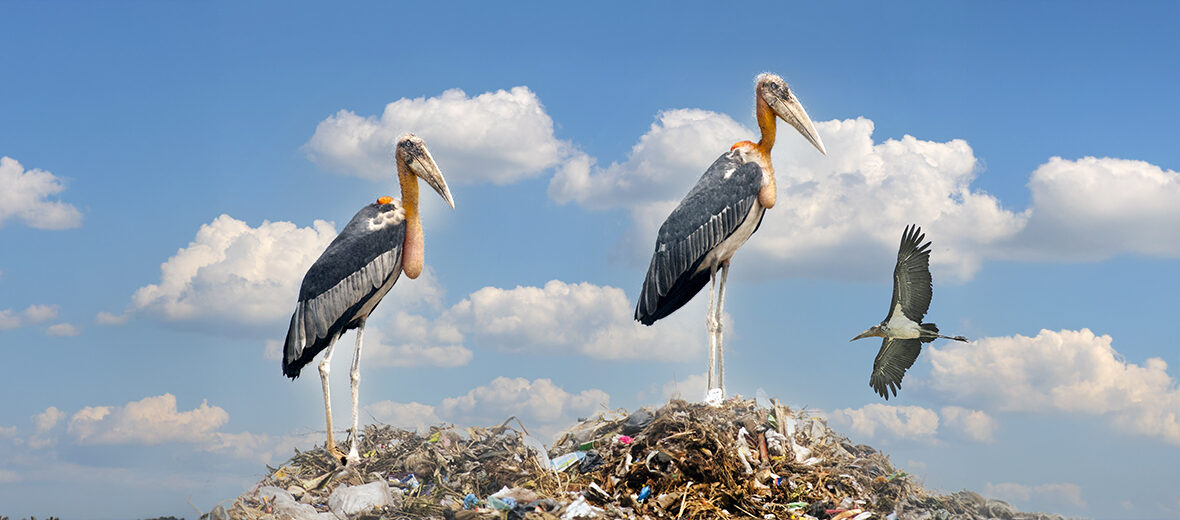
The greater adjutant, a member of the stork family, shares its genus with the lesser adjutant of Asia and the marabou stork of Africa. Once inhabiting much of southern Asia and mainland southeast Asia, these storks are now restricted to a far smaller range with only 3 breeding populations; 2 in India, 1 in the north-eastern state of Assam, a smaller 1 around Bhagalpur; and yet another breeding population in Cambodia. These birds face the threats of habitat loss and destruction at the hands of residential and commercial developments, farming, ranching, logging, marine and freshwater aquaculture, fires, and fire suppression efforts; hunting; trapping; recreational activities, that interrupt their breeding grounds; invasive species, that can bring about diseases; land pollution; and water pollution. The IUCN lists these birds as Near Threatened, but their numbers are increasing, albeit slowly.
First the Stats…
Scientific name: Leptoptilos dubius
Weight: Up to 24 lbs.
Length: Up to 25+ inches
Height: Up to 4.11 feet
Wingspan: Up to 8.2 feet
Lifespan: Up to 40+ years
Now on to the Facts!
1.) As of 2023, there were an estimated 1,510 wild individuals.
2.) Other common names are the Calcutta adjutant and hargila.
3.) They were first described by the English ornithologist John Latham, in 1785.
4.) These storks are currently placed in the genus Leptoptilos that was introduced in 1831 by the French naturalist René Lesson.
5.) A primary difference between the lesser adjutant and the greater adjutant is the absence of a gular pouch in the lesser adjutant. Then there is also the size difference.
But wait, there’s more on the greater adjutant!
6.) While mostly silent, these birds can produce a low grunting, mooing, or roaring sound which is made when nesting. They also engage in bill-clattering.
7.) Typically found alone or in small groups they stalk their food in shallow lakes or drying lake beds, as well as garbage dumps. They are typically found associating with kites and vultures and will sometimes sit hunched still for long periods of time.
Did you know…?
Most storks fly with their neck outstretched, but the 3 Leptoptilos species retract their neck in flight like herons do, likely due to their heavy bill. When walking on the ground, they have a stiff marching gait from which the name “adjutant” hails.
8.) On hotter days, they often hold their wings outstretched, presumably to control their core temperature.
9.) During the mating season, when a female perches nearby, the males will pluck fresh twigs and place them before her. The male sometimes also grasps the tarsus (feet) of the female with his bill or holds his bill close to her in a preening gesture.
10.) Eggs are laid at intervals of 1 – 2 days and incubation begins after the first egg is laid.
But wait, there’s still more on the greater adjutant!
11.) Both parents participate in incubation duties and the eggs hatch 35 days after being laid.
12.) Adults engage in urohidrosis (excreting feces on their legs) in order to cool themselves off on hotter days.
Did you know…?
Captive birds have been found to be rather susceptible to avian influenza (H5N1), and a high mortality rate was documented at a facility in Cambodia, with 2/3 of infected birds dying.
13.) While primarily being scavengers, these birds will also prey on frogs, fish, large insects, reptiles, mice, rats, and birds. They have been documented attacking wild ducks within reach, and swallowing them whole! They also feast on carrion (dead animals).
14.) Like vultures their bare head and neck is an evolutionary adaptation that aids in disease prevention and cleanliness.
15.) They are plagued with at least 2 species of bird lice, Colpocephalum cooki and Ciconiphilus temporalis.
But wait, there’s still a tad more on the greater adjutant!
16.) Nearly 15% of chicks are killed when they fall out of their nests and die of starvation. To counter this mortality some conservationists have utilized nets positioned below the nests to prevent injuries to falling young. These fallen birds are later fed and raised in situ for about 5 months and later released to join their wild cohorts.
17.) Outreach efforts including cultural and religious programming, primarily aimed at village women, have resulted in residents conserving the birds. The locals, who formerly thought of the birds as pests, now see the storks as special and take pride in protecting them and the trees in which they breed.
18.) Some locals have even added prayers for the safety of these storks to hymns, and included stork designs to the motifs used in traditional weavings.
19.) Folk-medicine practitioners believe that a piece of stork flesh chewed daily with betel (a species of flowering plant in the pepper family) could cure leprosy.
Now a Short Greater Adjutant Video!
Be sure to share & comment below! Also, check out the Critter Science YouTube channel. Videos added regularly!

Want to suggest a critter for me to write about? Let me know here.
Some source material acquired from: Wikipedia & IUCN
Photo credit: Yathin S. Krishnappa



